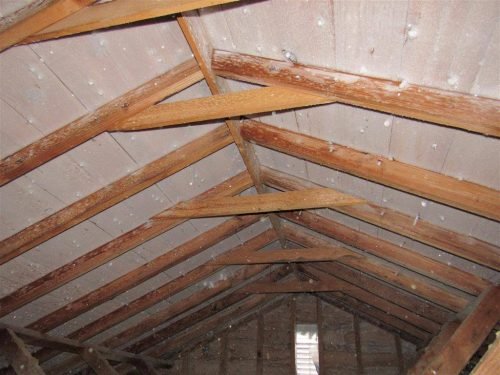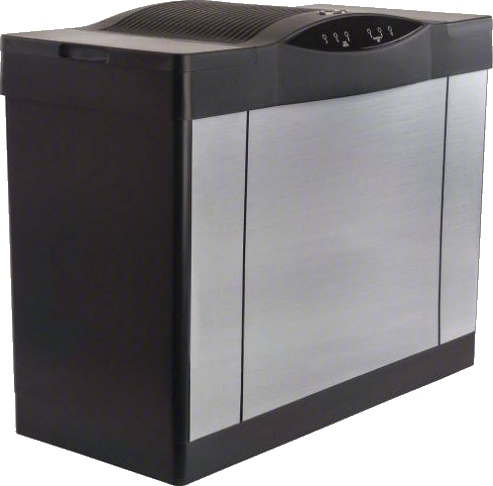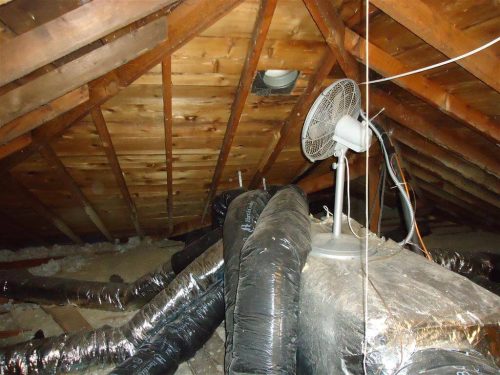If you have a problem with frost in your attic, you’re not alone. With the recent cold snap of weather here in Minnesota, I’ve talked to many contractors who are dealing with frost in their clients homes.

Nobody knows or cares about the frost until it gets warm, like last week. Then, the frost reveals itself with mysterious ceiling stains and water dripping out of light fixtures and bathroom exhaust fans. This is what happens when all of that frost melts. This is a building science issue, and it has nothing to do with your roof, so don’t bother calling a roofer to fix this problem.
To start, frost accumulates when moisture-laden air from the house enters the attic. When it hits cold surfaces like roof nails, it condenses. As the attic gets colder, frost accumulates on other materials, such as the roof sheathing and even the roof vents. Frost itself doesn’t do any damage, but once it melts, things get wet, and then damage occurs. Melting frost can lead to deteriorated roof sheathing, mold on the roof sheathing, wet insulation, and water stains on the ceilings.
Frost comes from air leaks
Frost gets into the attic from air leaks, or attic bypasses. I’ve blogged about attic air leaks many times, and I’ve shared photos of attic air leaks; check out my post on moldy attics for some good examples of attic bypasses. Of course, any type of exhaust fan needs to be exhausted directly to the exterior, and never into the attic. Even if the exhaust fan is aimed at a roof vent, this isn’t good enough. A lot of moist air will still find its way back into the attic.
The best way to prevent frost accumulation in an attic is to seal off attic air leaks. Click the following link for an excellent guide to attic air sealing from the fine folks at Building Science Corporation. While relatively small air leaks may not seem to be important, these can add up to a lot of frost accumulation in the attic. It’s important to seal all attic air leaks; not just the big ones. Once every little air leak has been perfectly sealed, the attic will be frost-free. The only problem with doing all of this air sealing is that the air leaks are located underneath the attic insulation, and it can be very difficult to find every air leak without completely removing the attic insulation. For this reason, it’s nice to start with the easier stuff first.
How to lower indoor humidity
The more humid a house is, the more frost you’ll find in the attic. Houses with the worst frost problems are the ones with whole-house humidifiers running rampant, which is why I’m not a fan of humidifiers. They can destroy houses. Oh, and those portable humidifiers so huge they come on wheels?
Those are whole-house humidifiers too. If you have a frost problem in your attic, be sure to take care of all the easy, obvious stuff before crawling around in your attic. And for the love of your house, turn your humidifier off.
Replace the standard switches on your bathroom exhaust fans with timer switches that will run the fans for an hour at a time, or use one with a built-in humidity sensor. Once those timers are installed, train everyone in the house to run the bathroom fan for 60 minutes after every shower or bath; this is how long it takes to get indoor humidity levels back to normal. Just running a fan while taking a shower won’t do much.
If you don’t have exhaust fans installed in bathrooms that are used for showers or bathing, fix that. I don’t care what the building code says, you need a fan in these bathrooms.
If you have a kitchen exhaust fan, use it while cooking. Gas ovens generate a lot of moisture, and so does boiling water.
Consider installing an air exchanger, such as a Heat Recovery Ventilator (HRV) or an Energy Recovery Ventilator (ERV) if you don’t have one. HRVs replace damp indoor air with dry outdoor air and recapture a fair amount of heat at the same time. This will dramatically lower humidity levels in the home. If you already have an HRV, make sure it’s properly installed, properly maintained, and operating.
If you have too many plants (or weeds) in your home, get rid of ’em. I can’t say how many is too many, I just know it when I see it.
If you have a damp basement or a crawl space with no vapor barrier, fix it. These are both major contributors to indoor humidity and attic problems.
House pressure affects frost
With all other factors being equal, the air in your house sees your house as a very wide chimney, because warm air rises. The trend is to have air leaving the house at the top and entering the house at the bottom. The taller the house, the greater this effect. Split-level homes with more than one attic space will always have the worst attic problems in the uppermost attic.
When a home has a combustion air duct connected to the return plenum, the house gets pressurized when the furnace runs, which increases the effects of attic air leaks. Combustion air ducts should not be connected to return plenums; they should just be dropped down into the room.
Unbalanced HVAC ductwork can also cause pressure problems. If there are too many return openings in the ductwork in the basement, the basement will be under negative pressure while the upper levels are under positive pressure. Sealing up all of the holes and gaps in your furnace ductwork can actually help to decrease the severity of attic air leaks. One simple test to find out if your basements “sucks” is to position a door to the basement about 1″ away from being closed, then turn the furnace fan on. If the door closes by itself, it’s an obvious sign that the ductwork is not properly balanced.
Will more insulation help? No way.
Adding insulation to your attic will not fix your frost problems. In fact, it will make things worse. If an attic doesn’t have enough insulation, it will be warm. Adding insulation will make the attic colder, but it will not stop the movement of moisture-laden air. The colder it is in the attic, the greater the potential for frost accumulation. Insulation should only be added after air sealing has been performed. If it’s not in the budget to do both, just have the air sealing done. This is much more important.
What about more roof vents?
Meh. Focus on all the other stuff listed above first. Proper ventilation in the attic may reduce frost accumulation, but if done wrong, simply adding more roof vents might actually make for more frost. Lack of attic ventilation does not cause frost to accumulate in an attic.
What if your attic is already covered with frost?
If your attic is already a frosty winter wonderland, what can you do to minimize damage from the melt? Unfortunately, not much. Some homeowners have told me they had decent luck running room fans in their attic to help improve the evaporation of the frost before it melts.
If there’s a way to couple that with bringing in outdoor air, it would surely help to speed up evaporation. But running a traditional attic fan, one that pulls air out of the attic, will probably make things even worse. This is because they’ll pull even more conditioned house air into the attic space. If you have a ridiculous amount of frost in your attic, you might consider laying out tarps or sheets of poly to help catch the water. But if it’s just frosted-over nail heads, this likely won’t be enough water to cause any serious damage.
Related Post: Roof Vents: Problems and Solutions



Ruth Belmonte
January 9, 2018, 7:01 am
Hello Reuben –
Your blog regarding yesterdays thawing is fabulous!
We have unfinished attic space that is giving us a lot of problems over the years, this year in particular. I think I may have helped along this year, I left the access door open for quite a while (over night) would that be why there is so much water leaking; thinking about frost creation on top of the other air leaks.
Reuben Saltzman
January 9, 2018, 2:58 pm
Thanks, Ruth!
John
January 9, 2018, 7:54 am
Great post,
What is the best way to clean up if existing frost and now water dripping is taking place??
Reuben Saltzman
January 9, 2018, 2:59 pm
Hi John,
I don’t have any great suggestions. I’m afraid you’ll have to just wait it out. If your insulation gets saturated, you would be best off replacing it.
Joe Maki
January 9, 2018, 7:55 pm
Do you have a company you can refer that does air sealing of an attic? Maple Grove area. Thanks
Reuben Saltzman
January 10, 2018, 5:23 am
Yes, http://www.atticusinsulation.com/ . They’re great.
Randy Morrison
January 10, 2018, 9:09 am
Hi Reuben,
May I share your blog posts?
Thanks Randy.
Randy Morrison
January 10, 2018, 9:11 am
Hi Reuben,
May I share your blog post?
Thanks, Randy
Reuben Saltzman
January 10, 2018, 9:12 am
Hi Randy,
Yes, definitely. Please and thank you 🙂
Justin
January 14, 2018, 10:28 am
We have a bathroom fan that leaks when it is really cold like now. Do you a recommendation for a company that can check the fan, duct work, insulation, damper, etc, and perform the fix?
Reuben Saltzman
January 15, 2018, 2:00 pm
Hi Justin,
My go-to company for that kind of stuff is Atticus: http://www.atticusinsulation.com/ . I don’t know for certain that they’d come out to just check on a bath fan issue, but they would be my first call.
Adding attic insulation? Read this first. - Structure Tech Home Inspections
January 16, 2018, 6:07 am
[…] bypasses are the driving force behind ice dams, as well as frost, moisture, and mold in the attic. If you eliminate all attic bypasses, you’ll probably […]
Mike
January 18, 2018, 2:39 pm
Noticed two stains last weekend, underside of roof was completely frosted over. Seems like a lot of it going around this time of year. Was told by a co-worker to add more insulation but what you say seems to make sense. If we decided to have spray foam insulation done that would seal the attic as well, right? Thanks for the post (or re-post)!
Reuben Saltzman
January 18, 2018, 2:42 pm
If spray foam is properly installed, then yes. That would address most of the air leaks.
Todd
January 19, 2018, 4:29 pm
Absolutely a partial reasoning for frost in an attic! Call a professional insulator who understands insulation, roofing and ventilation. Don’t overthink the problem, good solid reputable advice from an expert who has direct knowledge and will stand behind results. Don’t, and I truely mean “Don’t” pay an inspector! You will pay for his opinion, not final results…….
Reuben Saltzman
January 20, 2018, 4:46 am
Hi Todd,
You say “partial reasoning”. Would you care to share what the rest of the reasons are for frost in an attic?
As for your advice to not hire a home inspector to do what a home inspector does (inspect), what are you basing that on? I think most people already know that you don’t pay an inspector for results, you pay for his or her opinion. You pay for the unbiased truth, and that’s what we deliver.
Dianna Keating
January 31, 2018, 10:37 am
Does anyone in Delaware have this probem this month. I had a stain in my upper floor of house and being told this is the issue.
Kevin Napier
February 3, 2018, 8:07 pm
Hi Reuben.
Love your Blogs
I live in WV, todays temps were around 35. Last night it got down to 8 degrees. The house I inspected today 2/3/18 had frost in the attic. All I read is sealing bypasses. What is the solution if the house has a propane furnace in the attic?
Thank You
Kevin Napier
Greenbrier Home Inspections
Reuben Saltzman
February 4, 2018, 5:39 am
Hi Kevin,
If there were no air leaking out of the furnace and ductwork, the furnace wouldn’t have any effect on frost whatsoever. But I’m sure there’s air leaking out all over the place, and that’s what causing the frost. Those air leaks need to be sealed.
Chyrl Thompson
February 9, 2018, 3:22 pm
Hi Reuben, We live in Southern New Jersey. We put a new roof on our house in May 2017, we built the house in 1996. The beginning of January 2018 we noticed frost in the attic, the temps outside were very cold. It’s a split level and the problem is only in the upper side of the roof(the second floor over the basement). Never had an issue until roof and different ridge vent was installed. What could be causing this, how do we fix it and could you recommend someone in my area. We have called several insulators and they are not sure what the problem is. They just want to blow a foot of insulation up there over the wet stuff that we now have. Hope you can help! Chyrl
Reuben Saltzman
February 9, 2018, 3:34 pm
Hi Chyrl,
The cause and solution of the frost is everything that I listed here. To find someone in your area who can actually fix it, use the search feature at the Building Performance Institute’s website: http://www.bpi.org/locator-tool/find-a-contractor
Rosie
April 2, 2018, 1:01 pm
What is your opinion on the necessity to install a constant fan in the bathroom after sealing the attic? I’ve been told conflicting opinions. One contractor told me it’s not necessary. Another told me that it’s absolutely necessary because the house will be too tight.
Reuben Saltzman
April 2, 2018, 1:07 pm
Hi Rosie,
Air sealing the attic is one of many variables that can affect humidity in a home. I don’t think that anyone could definitely say that performing air sealing alone will cause a moisture problem. My advice would be to wait and see.
Rosie
April 2, 2018, 1:57 pm
Thanks Reuben. So you wouldn’t strictly rely on having an “after” blower door test that decides whether or not to install a vent? You’re saying that the necessity would be evidenced by a moisture problem in our living space? What type of moisture would we see and how soon after air sealing the attic would it be evident? We need to fix a condensation issue in the attic. However we don’t want to install a continuous running fan if it’s not necessary!
Reuben Saltzman
April 2, 2018, 2:02 pm
An “after” blower door test would give you the best educated guess as to whether or not you’ll need a ventilation system. This is the best thing that a contractor could offer you, but it’s not definitive. If you find condensation on your windows during the winter that never used to be there, you probably need a ventilation method.
Norm
March 9, 2018, 11:03 am
What happens if I block all vents off , I have no cold air coming in .
Reuben Saltzman
March 9, 2018, 11:33 am
You’ll increase the potential for frost accumulation and ice dams.
Joe
March 11, 2018, 11:07 am
I have structural panels for my roof I noticed condensation dripping under metal roof why?
Negotiations after the inspection - Structure Tech Home Inspections
March 20, 2018, 4:08 am
[…] or frost in the attic, and/or major ice dam issues. The fix for both of these is to address attic air leaks, insulation, […]
Jake Waxman
January 26, 2024, 10:09 am
Two questions:
1) Our house was built in 2017 but I think our attic is overly frosty and we get water dripping in places it shouldn’t after a thaw. Was it code in MN in 2017 to air seal fixtures etc in the attic?
2) Do you still recommend Atticus for attic air sealing?
Reuben Saltzman
January 26, 2024, 10:59 am
Hi Jake,
1. Yes, it was code in 2017 to air seal fixtures in the attic.
2. I recommend either of these companies: https://uzinsulation.com/ or https://www.houleinsulation.com/